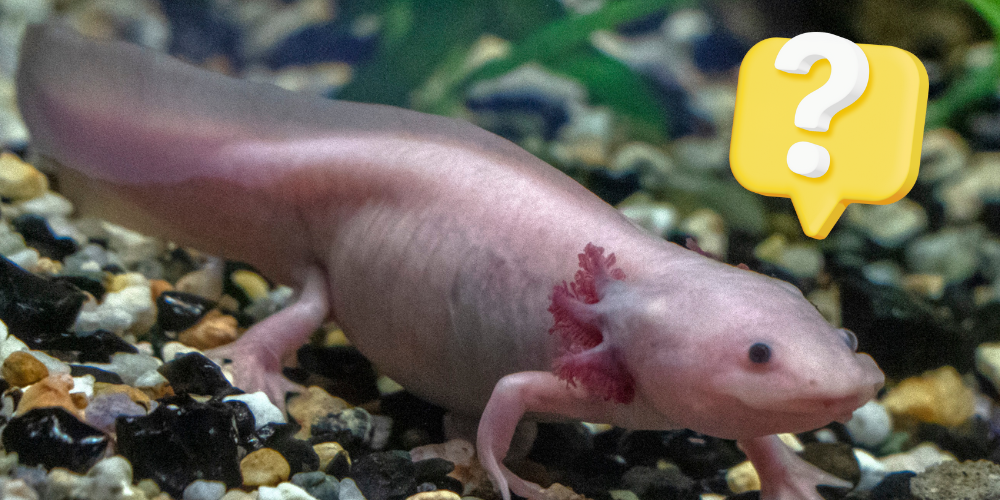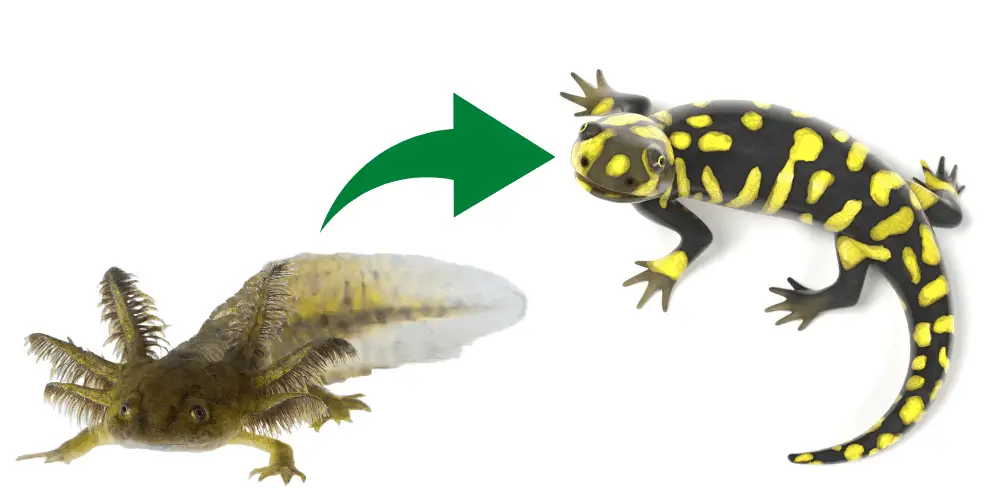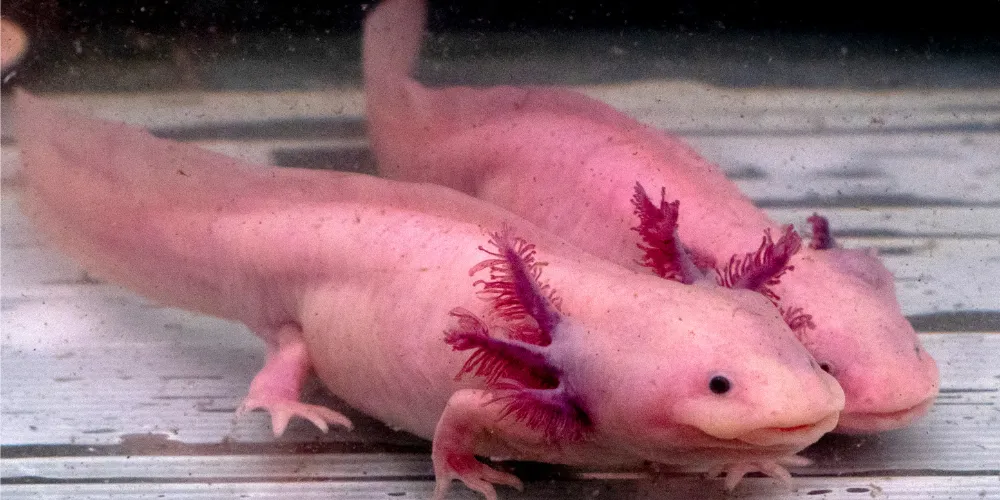Axolotls are fascinating creatures that make for unique pets. But what do axolotls eat?
Axolotls eat small live prey like insect larvae, brine shrimp, worms, tadpoles, and small fish in the wild. In captivity, they eat nutritious protein-rich foods, including earthworms, bloodworms, pellets, brine shrimp, and small feeder fish. Axolotls should be fed 1-2 times per day. Overfeeding should be avoided.
This guide covers everything you need to know about feeding axolotls, including their diet in the wild and captivity.
Key Takeaways
- Axolotls are carnivores that eat live prey like worms and larvae in the wild.
- In captivity, they require a protein-rich diet of foods like earthworms, brine shrimp, and pellets.
- Juvenile axolotls need more frequent, smaller meals than adult axolotls.
- Limit portions and remove uneaten food quickly to prevent water fouling.
- Avoid feeder fish and land-based proteins, which can cause health issues.
- Vary food types for nutritional completeness and axolotl health.
- Maintain excellent water quality in addition to a proper diet.
- Monitor axolotl growth, behavior, and appearance for signs of malnutrition.
- Research foods thoroughly and consult experts for optimal axolotl nutrition.
What is an Axolotl?
Axolotls are a unique type of salamander native to Mexico. They are fully aquatic, meaning they live their entire lives underwater. Axolotls have some very fascinating characteristics that make them unusual amphibians:
- They have external gills and finned tails that resemble fish, but axolotls are actually a type of salamander.
- Axolotls exhibit neoteny, meaning they retain gills and other larval features their whole lives instead of developing into terrestrial adults like most amphibians.
- Their scientific name is Ambystoma mexicanum, as they come from Mexico and are part of the tiger salamander family.
- In the wild, axolotls inhabit Lake Xochimilco near Mexico City. But they are now critically endangered with very few left in their native habitat.
- Axolotls are known for their amazing regenerative abilities – they can regrow lost limbs, heal wounds without scarring, and even regenerate parts of their brain and spine.
- As carnivores, axolotls eat small aquatic animals like worms, insect larvae, crustaceans, mollusks and small fish. Their diet consists mainly of live prey.
- Axolotls use their keen sense of smell and lateral line system to detect food in the water. They suck food into their large mouths to swallow prey whole.
Axolotls are unique, fully aquatic salamanders only found in Mexico. Their neotenic traits, regenerative abilities, and carnivorous habits make them fascinating creatures!
Why Is Proper Nutrition Important for Axolotls?
Feeding axolotls a balanced, nutritious diet is extremely important for their health and well-being. Axolotls fed inadequate or poor-quality diets are prone to developing several issues:
- Stunted growth and development – Axolotls need proper nutrition to reach their full size potential. Lack of key vitamins and minerals will cause stunted growth.
- Increased disease susceptibility – Malnutrition weakens the immune system, making axolotls more prone to illnesses and infections.
- Shortened lifespan – Poor diet leads to cumulative health issues that can sadly shorten an axolotl’s life. Well-fed axolotls live 10-15 years.
- Bone and skeletal deformities – Improper calcium/phosphorus ratios can cause metabolic bone disease and spinal curvatures.
- Organ dysfunction – Nutrient deficiencies can damage the liver, kidneys and other organs over time.
- Behavioral problems – Hunger or malnutrition may cause increased aggression or abnormal repetitive behaviors.
The best way to avoid these issues is by feeding axolotls a balanced, varied diet high in protein and low in fat.
Key food components include earthworms, brine shrimp, bloodworms, pellets and occasional feeder fish.
Varying food types ensures they receive all the essential amino acids, vitamins and minerals needed to thrive.
While more research is still needed, current evidence suggests mixed diets with diverse nutrition are optimal for axolotl health and welfare.
Careful attention to diet is crucial for your pet’s happiness and longevity!
What Do Axolotls Eat in the Wild?
In their native habitat of Lake Xochimilco in Mexico City, axolotls are opportunistic predators that feed on a variety of small aquatic animals.
Their diet in the wild consists mainly of live prey. Some common food sources for wild axolotls include:
- Small fish – Minnows, guppies, tetras and other small fish are readily consumed by axolotls. They swallow them whole.
- Insect larvae – Mosquito larvae, mayfly larvae and other insect larvae are nutritious prey items.
- Brine shrimp – These small crustaceans are part of the axolotl’s natural diet.
- Worms – Blackworms, tubifex worms and small earthworms are staple foods.
- Snails – Small pond snails and other mollusks provide nutrition.
- Tadpoles – Axolotls will eat frog and toad tadpoles.
- Crustaceans – Daphnia, copepods, and other tiny crustaceans are preyed upon.
Axolotls are voracious predators and eat whatever meaty foods they can capture and swallow whole.
They use their keen sense of smell to locate live prey in their aquatic habitat.
As opportunistic hunters, axolotls will consume any protein source available, allowing them to thrive in Lake Xochimilco’s ecosystem.
Their unique suction feeding method allows them to suck in food from the water.
In the wild, axolotls play an important role as predator and prey.
What Do Axolotls in Captivity Eat?
While similar to their wild counterparts, captive axolotls are fed a more varied diet to ensure balanced nutrition. Some key differences include:
- More variety – In captivity, axolotls are fed a wider range of food items like worms, shrimp, fish, and pellets to provide a complete diet.
- Commercial foods – High quality pellets and frozen foods like bloodworms are convenient options commonly used for pet axolotls. These are nutritionally formulated for axolotls.
- Less live foods – Live foods can introduce parasites, so they are fed more sparingly to captive axolotls. Frozen and freeze-dried options are safer.
Some common foods fed to captive axolotls include:
- Earthworms – Chopped up nightcrawlers are a nutritious staple food.
- Bloodworms – Both live and frozen bloodworms offer protein and nutrients.
- Brine shrimp – Frozen brine shrimp provide a good food source, especially for young axolotls.
- Daphnia – Live or frozen daphnia give additional variety.
- Axolotl pellets – Specially made pellets deliver balanced nutrition.
- Small feeder fish – Offered occasionally, but sparingly due to parasite risks.
Varying food types ensures captive axolotls receive well-rounded nutrition to support their health and growth. Careful research on diet is needed to keep pet axolotls thriving.
How Often Should You Feed Your Axolotl?
Axolotls should be fed at different frequencies depending on their age and size:
- Baby axolotls need to be fed 2-3 times per day. Offer live brine shrimp and let them eat as much as they want in 10-15 minutes. Remove any uneaten food. Their rapid growth requires frequent feedings.
- Juvenile axolotls should be fed 1-2 times per day. Give them enough food to eat in a 15 minute period before removing uneaten food. Their metabolism is still fast.
- Adult axolotls only need to be fed every 2-3 days. Feed adult axolotls an amount of food about the size of their head. They eat less frequently.
Some key points on feeding frequency:
- It’s better to underfeed than overfeed axolotls to prevent obesity issues slightly.
- Uneaten food should always be promptly removed from the tank after feeding time to maintain good water quality.
- If your axolotl seems overly hungry or loses weight, try offering food more frequently.
- Monitor your individual pet’s appetite and weight, adjusting feeding schedules as needed.
- Consistency is important – establish a routine for optimal axolotl health.
You can keep your axolotl well-nourished and healthy with age-appropriate feeding amounts and frequency!
Food Types to Avoid
Here are some common food types that should be avoided for axolotls:
- Feeder fish from pet stores
- Feeder fish pose a high risk of introducing parasites or diseases into the aquarium. It is safer to feed axolotls earthworms, brine shrimp, or high quality pellets instead.
- Human foods
- Chicken, beef, pork, or vegetables are not part of an axolotl’s natural diet. As carnivores, axolotls should only eat aquatic protein sources.
- Hard-bodied foods
- Foods with tough exoskeletons like crickets or crayfish can injure an axolotl’s digestive system and should be avoided.
- High-fat foods
- While axolotls need protein, too much fat can cause liver problems. Limit high-fat foods like beef heart.
- Unhealthy feeder fish
- Cheaper feeder fish are often raised in poor conditions and fed poor diets. This increases disease risks.
- Expired frozen foods
- Eating spoiled, expired frozen foods can make axolotls very sick. Always check dates first.
Stick to recommended foods like earthworms, axolotl pellets, brine shrimp, and occasional treats like bloodworms.
Avoid land-based proteins and foods with potential health risks. Research any new foods thoroughly before feeding to ensure they are safe and nutritious for axolotls.
Conclusion
In summary, axolotls are unique carnivorous amphibians with specific dietary requirements.
In the wild, they eat live prey like small fish, insect larvae, worms, and crustaceans.
As pets, axolotls thrive best on a varied diet including earthworms, brine shrimp, bloodworms, and high-quality pellets.
Feeding frequency should be adjusted based on age, with babies needing more daily meals.
It’s important to limit portions to prevent obesity issues. Removing uneaten food promptly, avoiding certain high-risk foods, and maintaining excellent water quality are also key to axolotl health.
With the proper diet and care, the fascinating and low-maintenance axolotl can live a long, healthy life in captivity.
Understanding their nutritional needs is essential for any potential axolotl owner.
READ MORE AXOLOTL TOPIC BELOW:
- Do People Eat Axolotls: The Ethical and Cultural Debate
- Can Axolotls Breathe Air? ( Water’s Whispered Secret! )
- Can Axolotls Live with Turtles?
REFERENCES:
Axolotl. (2023, September 14). In Wikipedia. https://en.wikipedia.org/wiki/Axolotl



